Astrological aspect
This article needs additional citations for verification. (September 2014) |

In astrology, an aspect is an angle the planets make to each other in the horoscope, also to the ascendant, midheaven, descendant, lower midheaven, and other points of astrological interest. Aspects are measured by the angular distance in degrees and minutes of ecliptic longitude between two points, as viewed from Earth. According to astrological tradition, they indicate the timing of transitions and developmental changes in the lives of people and affairs relative to the Earth.
As an example, if an astrologer creates a horoscope that shows the apparent positions of the celestial bodies at the time of a person's birth (a natal chart), and the angular distance between Mars and Venus is 92° ecliptic longitude, the chart is said to have the aspect "Venus square Mars" with an orb of 2° (i.e., it is 2° away from being an exact square; a square being a 90° aspect). The more exact an aspect, the stronger or more dominant it is said to be in shaping character or manifesting change.[1]
Approach[]
In medieval astrology, certain aspects, like certain planets, were considered to be either favorable (benefic) or unfavorable (malefic). Modern usage places less emphasis on these fatalistic distinctions. The more modern approach to astrological aspects is exemplified by research on astrological harmonic, of which John Addey was a major proponent, and which Johannes Kepler earlier advocated in his book Harmonice Mundi in 1619. But even in modern times, aspects are considered either hard[further explanation needed] (the 90° square, the 180° opposition) or easy[further explanation needed] (the 120° trine, the 60° sextile). The conjunction aspect (essentially 0°, discounting orb) can be in either category, depending on which two planets it is that are conjunct.
A list of aspects below presents their angular values and a recommended orb for each aspect. The orbs are subject to variation, depending on the need for detail and personal preferences.
Ptolemaic Aspects[]
The traditional major aspects are sometimes called Ptolemaic aspects since they were defined and used by Ptolemy in the 1st Century, AD. These aspects are the conjunction (0°), sextile (60°), square (90°), trine (120°), and opposition (180°). It is important to note that different astrologers and separate astrological systems/traditions utilize differing orbs (the degree of separation between exactitude) when calculating and using the aspects, though almost all use a larger orb for a conjunction when compared to the other aspects. The major aspects are those that can be used to divide 360 evenly and are divisible by 10 (with the exception of the semi-sextile).[2]
Kepler's Aspects[]
Johannes Kepler described 13 aspects in his book Harmonice Mundi in 1619, grouping them in five degree of influentiality. He picked these from symbol ratios he encountered in geometry and music: 0/2, 1/2, 1/5, 1/6, 1/3, 1/12 along with 1/5, 2/5, 12/5, 10, 10/3, 8, and 8/3. The general names for whole divisors are (Latin) n-ile for whole fractions 1/n, and m-n-ile for fraction m/n. A semi-n-tile is a 2n-tile, 1/(2n), and sesqui-n-tile is a tri-2n-tile, 3/(2n).
All aspects can be seen as small whole number harmonics, (1/n of 360°), and multiples m/n create new aspects where there are no common factors between n and m, gcd(n,m)=1.
| Degree of Influentiality |
First | Second | Third | Fourth | Fifth | ||||||||
|---|---|---|---|---|---|---|---|---|---|---|---|---|---|
| Aspect | Conjunction | Opposition | Quartile Square |
Trine (bisextile) |
Sextile (semitrine) |
Semisextile (duodecile) |
Quincunx (quinduodecile) |
Quintile (bidecile) |
Biquintile | Octile (semisquare) |
Trioctile (sesquiquadrate) |
Decile (semiquintile) |
Tridecile (sesquiquintile) |
| Glyph |  |
 |
 |
 |
 |

|
 |
 |
 |
 |
 |
 |
 3 3
|
| Angle | 0° | 180° | 90° | 120° | 60° | 30° | 150° | 72° | 144° | 45° | 135° | 36° | 108° |
| Fraction | 0/2 | 1/2 | 1/4 | 1/3 | 1/6 | 1/12 | 5/12 | 1/5 | 2/5 | 1/8 | 3/8 | 1/10 | 3/10 |
| Regular polygon |
 Monogon |
 Digon |
 Square |
 Triangle |
 Hexagon |
 Dodecagon |
 Dodecagram |
 Pentagon |
 Pentagram |
 Octagon |
 Octagram |
 Decagon |
 Decagram |
Major aspects[]

Conjunction[]

A conjunction (abrv. Con) is an angle of approximately 0–10°. An orb of approximately 10° is usually considered a conjunction, but if neither the Sun nor Moon is involved, some consider the conjunction to have a maximum orb of only about 8°.
Conjunctions are said to be the most powerful aspect, mutually intensifying the effects of the planets involved; they are major point in an individual's chart. Whether the conjunction in question is regarded as beneficial or detrimental depends on the specific planets involved. In particular, conjunctions involving the Sun, Venus, and/or Jupiter, in any of the three possible conjunction combinations, are considered highly favourable, while conjunctions involving the Moon, Mars, and/or Saturn, again in any of the three possible conjunction combinations, are considered highly unfavourable.[3]
Exceptionally, the Sun, Venus, and Jupiter were in a 3-way (beneficial) conjunction on November 9–10, 1970, while on March 10 of that same year, the Moon, Mars, and Saturn were in 3-way (detrimental) conjunction.
If either of two planets involved in a conjunction is also under tension from one or more hard aspects with one or more other planets, then the added presence of the conjunction aspect will further intensify the tension of that hard aspect.
A planet in very close conjunction to the Sun (within 17 minutes of arc, or only about 0.28°) is said to be cazimi, an ancient astrological term meaning "in the heart" (of the Sun). For example, "Venus cazimi" means Venus is in conjunction with the Sun with an orb of less than ≈ 0.28°. Such a planetary position is a conjunction of great strength. A related term is combust, applicable when the planet in conjunction with the Sun is only moderately close to the Sun. In the case of combust, specific orb limit will depend on the particular planet in conjunction with the Sun.
The Sun and Moon experience a conjunction every single month of the year — during the New Moon.
Great conjunctions[]
 Jupiter and Saturn's great conjunctions repeat every ~120°, Saturn's path relative to Jupiter in blue. The 3-fold pattern comes from a near 2:5 resonance, while their period ratio closer to 60:149 making 89 conjunctions, leading to a slow precession of the triangular pattern. |
 Kepler's trigon, a diagram of great conjunctions from Johannes Kepler's 1606 book De Stella Nova |
Great conjunctions (between the two slowest classical planets, Jupiter and Saturn) have attracted considerable attention in the past as celestial omens. During the late Middle Ages and the Renaissance, great conjunctions were a topic broached by most astronomers of the period up to the times of Tycho Brahe and Kepler, by scholastic thinkers as Roger Bacon[4] or Pierre d'Ailly,[5] and they are mentioned in popular and literary writing by authors such as Dante[6] and Shakespeare.[7] This interest is traced back in Europe to the translations from Arabic sources, most notably Albumasar's book on conjunctions.[8]
Successive great conjunctions move retrograde ~120° every 20 years. Sequential conjunctions appear as triangular pattern, repeating every third conjunction returns after some 60 years to the vicinity of the first. These returns are observed to be shifted by some 8° relative to the fixed stars, so no more than four of them occur in the same zodiacal sign. Usually the conjunctions occur in one of the following triplicities or trigons of zodiacal signs:
| Element | Conjunction 1 | Conjunction 3 | Conjunction 2 | ||||||
|---|---|---|---|---|---|---|---|---|---|
| Sign | Sym | Number Ecliptic longitude |
Sign | Sym | Number Ecliptic longitude |
Sign | Sym | Number Ecliptic longitude | |
| Fire trigon | Aries | 1 (0° to 30°) | Leo | 5 (120° to 150°) | Sagittarius | 9 (240° to 270°) | |||
| Earth trigon | Taurus | 2 (30° to 60°) | Virgo | 6 (150° to 180°) | Capricorn | 10 (270° to 300°) | |||
| Air trigon | Gemini | 3 (60° to 90°) | Libra | 7 (180° to 210°) | Aquarius | 11 (300° to 330°) | |||
| Water trigon | Cancer | 4 (90° to 120°) | Scorpio | 8 (210° to 240°) | Pisces | 12 (330° to 360°) | |||
After about 220 years the pattern shifts to the next trigon, and in about 900 years returns to the first trigon.[9]
To each triangular pattern astrologers have ascribed one from the series of four elements. Particular importance has been accorded to the occurrence of a great conjunction in a new trigon, which is bound to happen after some 240 years at most.[10] Even greater importance was attributed to the beginning of a new cycle after all fours trigons had been visited, something which happens in about 900 years.
Medieval astrologers usually gave 960 as the length of the full cycle, apparently because in some cases it took 240 years to pass from one trigon to the next.[10] If a cycle is defined by when the conjunctions return to the same right ascension rather than to the same constellation, then because of axial precession the cycle is only about 800 years. Use of the Alphonsine tables apparently led to the use of precessing signs, and Kepler gave a value of 794 years (40 conjunctions).[10][6]
Despite the inaccuracies and some disagreement about the beginning of the cycle the belief in the significance of such events generated a stream of publications which grew steadily up to the end of the 16th century. As the great conjunction of 1583 was the last in the watery trigon it was widely supposed to herald apocalyptic changes; a papal bull against divinations was issued in 1586 and as nothing really significant had happened by 1603 with the advent of a new trigon, the public interest rapidly died.
Opposition[]
| Sym | Harmonic | Angle | Name |
|---|---|---|---|
| 1/1 | 360° (0°) | Conjunction | |
| 1/2 | 180° | Opposition | |
| 1/4 | 90° | Square or quartile/quadrate | |
| 1/8 | 45° | Octile or semi-square | |
| 3/8 | 135° | Tri-octile or sesqui-quadrate | |
| 1/16 | 22.5° | Sexdecile or semi-octile | |
| 3/16 | 67.5° | Sesqui-octile | |
| 5/16 | 112.5° | Quin-semi-octile | |
| 7/16 | 157.5° | Sep-semi-octile | |
| 1/3 | 120° | Trine or tri-novile | |
| 1/6 | 60° | Sextile or semi-trine | |
| 1/12 | 30° | Duodecile or semi-sextile | |
| 5/12 | 150° | Quincunx or quin-duodecile | |
| 1/24 | 15° | Quattuorvigintile or semi-duodecile | |
| 5/24 | 75° | "Squile" | |
| 7/24 | 105° | "Squine" | |
| 11/24 | 165° | "Quindecile"[12] or "contraquindecile" | |
| 1/5 | 72° | Quintile | |
| 2/5 | 144° | Bi-quintile | |
| D |
1/10 | 36° | Decile or semi-quintile |
| D3 |
3/10 | 108° | Tri-decile or sesqui-quintile |
| √ |
1/15 | 24° | Quindecile or trient-quintile |
| √2 |
2/15 | 48° | Bi-quindecile |
| √4 |
4/15 | 96° | Quadra-quindecile |
| √7 |
7/15 | 168° | Sep-quindecile |
| V |
1/20 | 18° | Vigintile or semi-decile |
| V3 |
3/20 | 54° | Tri-vigintile or sesqui-decile |
| V7 |
7/20 | 126° | Sep-vigintile |
| V9 |
9/20 | 162° | Non-vigintile |
| 1/40 | 9° | Quadragintile or semi-vigintile | |
| S |
1/7 | 51.43° | Septile |
| S2 |
2/7 | 102.86° | Bi-septile |
| S3 |
3/7 | 154.29° | Tri-septile |
| 1/14 | 25.71° | Semi-septile | |
| 3/14 | 77.14° | Tre-semi-septile or sesqui-septile | |
| 5/14 | 128.57° | Quin-semi-septile | |
| N |
1/9 | 40° | Novile |
| N2 |
2/9 | 80° | Bi-novile |
| N4 |
4/9 | 160° | Quadra-novile |
| 1/18 | 20° | Octodecile or semi-novile or "vigintile" | |
| 1/36 | 10° | Trigintasextile | |
| U |
1/11 | 32.83° | Undecile or undecim or "elftile"[13] |
| U2 |
2/11 | 65.45° | Bi-undecile or "bi-elftile" |
| U3 |
3/11 | 98.18° | Tri-undecile or "tri-elftile" |
| U4 |
4/11 | 130.91° | Quad-undecile or "quadr-elftile" |
| U5 |
5/11 | 163.63° | Quin-undecile or "quin-elftile" |

An opposition (abrv. Opp) is an angle of 180° (1/2 of the 360° ecliptic). An orb of somewhere between 5° and 10°[14] is usually allowed depending on the planets.
Oppositions are said to be the second most powerful aspect. It resembles the conjunction although the difference between them is that the opposition is fundamentally relational. Some say it is prone to exaggeration as it is not unifying like the conjunction but has a dichotomous quality and an externalizing effect. All important axes in astrology are essentially oppositions. Therefore, at its most basic, it often signifies a relationship that can be oppositional or complementary.[citation needed]
Sextile[]
A sextile (abrv. SXt or Sex) is an angle of 60° (1/6 of the 360° ecliptic, or 1/2 of a trine [120°]). An orb between 3-4 is allowed depending on the planets involved.
The sextile has been traditionally said to be similar in influence to the trine, but less intense. It indicates ease of communication between the two elements involved, with compatibility and harmony between them. A sextile provides opportunity and is very responsive to effort expended to gain its benefits.[citation needed] See information below on the semi-sextile.
Square[]

A square (or quartile) (abrv. SQr or Squ) is an angle of 90° (1/4 of the 360° ecliptic, or 1/2 of an opposition [180°]). An orb of somewhere between 5° and 10°[14] is usually allowed depending on the planets involved.
As with the trine and the sextile, in the square, it is usually the outer or superior planet that has an effect on the inner or inferior one. The square's energy is strong and usable but has a tension that needs integration between 2 different areas of life, or offers a choice point where an important decision needs to be made that involves an opportunity cost. It is the smallest major aspect that usually involves houses in different quadrants.[citation needed]
Trine[]

A trine (abbrev. Tri) is an angle of 120° (1/3 of the 360° ecliptic), an orb of somewhere between 5° and 10° depending on the planets involved.
The trine relates to what is natural and indicates harmony and ease. The trine may involve talent or ability which is innate. The trine has been traditionally assumed to be extremely beneficial. When involved in a transit, the trine involves situations that emerge from a current or past situation in a natural way.[citation needed]
Minor aspects[]
Semi-sextile[]
![]() A semi-sextile (or duodecile) is an angle of 30° (1/12 of the 360° ecliptic). An orb of ±1.2° is allowed.
A semi-sextile (or duodecile) is an angle of 30° (1/12 of the 360° ecliptic). An orb of ±1.2° is allowed.
It is the most often used of the minor aspects perhaps for no other reason than it can be easily seen. It indicates a mental interaction between the planets involved that is more sensed than experienced externally. Any major aspect transit to a given planetary position will also involve the other planet that is in semi-sextile aspect to it. The energetic quality is one of building and potentiating each other gradually, but planets, houses and signs involved must be considered. Similar to a sextile in offering a quality of opportunity with conscious effort to benefit from.[citation needed]
Quincunx[]
 A quincunx is an angle of 150° (5/12 of the 360° ecliptic). An orb of ±3.5° is usually allowed depending on the planets involved.
A quincunx is an angle of 150° (5/12 of the 360° ecliptic). An orb of ±3.5° is usually allowed depending on the planets involved.
Its effect is most obvious when there is a triangulating aspect of a 3rd planet in any major aspect to the 2 planets which are quincunx. Its interpretation will rely mostly on the houses, planets, and signs involved. The effect will involve different areas of life being brought together that are not usually in communication since the planets are far enough apart to be in different house quadrants, like the trine, but often with a shift in perspective involving others not previously seen clearly. Keywords for the quincunx are mystery, creativity, unpredictability, imbalance, surreal, resourcefulness, and humor.[citation needed]
It does not offer equal divisions of the circle, but represents the 150° turn angles of a dodecagram, {12/5}.
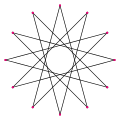
Dodecagram {12/5}
Other minor aspects[]
Quintile[]
 A quintile is an angle of 72° (1/5 of the 360° ecliptic). An orb of ±1.2° is allowed.
A quintile is an angle of 72° (1/5 of the 360° ecliptic). An orb of ±1.2° is allowed.
It indicates a strong creative flow of energy between the planets involved, often an opportunity for something performative, entertaining or expressive.[citation needed]
A decile, angle 36°, 1/10 of 360° is a semiquintile.
- Irreducible multiples
 A biquintile is an angle of 144° (2/5 of the 360° ecliptic). The 144° angle is shared with the pentagram.
A biquintile is an angle of 144° (2/5 of the 360° ecliptic). The 144° angle is shared with the pentagram.

Pentagram {5/2}
Septile[]
S A septile is an angle of roughly 51.43° (1/7 of the 360° ecliptic). An orb of ±1° is allowed.
It is a mystical aspect that indicates a hidden flow of energy between the planets involved, often involving spiritual or energetic sensitivity and an awareness of inner and more subtle, hidden levels of reality involving the planets in septile aspect.[citation needed]
- Irreducible multiples
- S2: A biseptile is an angle of 102.86° (2/7 of the 360° ecliptic).
- S3: A triseptile is an angle of 154.29° (3/7 of the 360° ecliptic).
Octile[]
 A octile (or semi-square) is an angle of 45° (1/8 of the 360° ecliptic). An orb of ±2° is allowed.
A octile (or semi-square) is an angle of 45° (1/8 of the 360° ecliptic). An orb of ±2° is allowed.
It is an important minor aspect and indicates a stimulating or challenging energy like that of a square but less intense and more internal. The semi-square is considered to be the 8th harmonic of the chart because it is one-eighth of the 360° circle that the zodiac resides in (i.e., 360 / 8 = 45). The semi-square is considered to be a minor hard aspect because it is thought to cause friction in the native's life and prompt them to take some action to reduce that friction.
For example, if the Sun is posited in 10° Aquarius and Venus is posited in 25° Pisces then a semi-square would occur. This is thought to indicate that the native is not likely to be totally happy in matters of love. The native is thought to have a tendency to seek out those individuals who are not necessarily compatible to them, and this may lead to a sense of tension and actions to correct what to them may be frustration.[citation needed]
- Irreducible multiples
 A sesquiquadrate (or trioctile) is an angle of 135° (3/8 of the 360° ecliptic). An orb of ±1.5° is allowed.
A sesquiquadrate (or trioctile) is an angle of 135° (3/8 of the 360° ecliptic). An orb of ±1.5° is allowed.
It is a harmonic of the semi-square, part of the square family aspect involving challenge. It is not an exact division of the 360° ecliptic and therefore does not function as a standalone aspect but as part of a series when a semi-square is present.[citation needed]
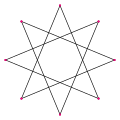
Octagram {8/3}
Novile[]
N A novile is an angle of 40° (1/9 of the 360° ecliptic). An orb of ±1° is allowed.
It indicates an energy of perfection and/or idealization.[citation needed]
- Irreducible multiples
- N2: A bi-novile is an angle of 80° (2/9 of the 360° ecliptic).
- N4: A quad-novile is an angle of 160° (4/9 of the 360° ecliptic).
Decile[]
![]() A decile is an angle of 36° (1/10 of the 360° ecliptic).
A decile is an angle of 36° (1/10 of the 360° ecliptic).
- Irreducible multiples
 3 A tri-decile is an angle of 108° (3/10 of the 360° ecliptic).
3 A tri-decile is an angle of 108° (3/10 of the 360° ecliptic).
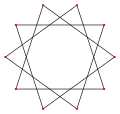
Decagram {10/3}
Undecile[]
U An undecile (or elftile[13]) is an angle of 32.73�� (1/11 of the 360° ecliptic). An orb of ±1° is allowed.
- Irreducible multiples
- U2: A bi-undecile is an angle of 65.45° (2/11 of the 360° ecliptic).
- U3: A tri-undecile is an angle of 98.18° (3/11 of the 360° ecliptic).
- U4: A quad-undecile is an angle of 130.91° (4/11 of the 360° ecliptic).
- U5: A quin-undecile is an angle of 163.63° (5/11 of the 360° ecliptic).

Hendecagram {11/2}
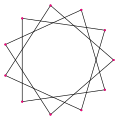
Hendecagram {11/3}
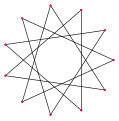
Hendecagram {11/4}

Hendecagram {11/5}
Semi-octile[]
A semi-octile (or sexdecile) is an angle of 22.5° (1/16 of the 360° ecliptic). An orb of ±0.75° is allowed.
It is part of the square family aspects and is considered a more minor version of the semi-square which triggers and involves challenge. Its harmonic aspects are 45°, 67.5°, 90°, 112.5°, 135°, 157.5° and 180°. It was discovered by Uranian astrologers.
- Irreducible multiples
- A sesqui-octile (or bi-sexdecile) is an angle of 67.5° (3/16 of the 360° ecliptic).
- A quin-semi-octile (or quin-sexdecile) is an angle of 112.5° (5/16 of the 360° ecliptic).
- A sep-semi-octile (or sep-sexdecile) is an angle of 157.5° (7/16 of the 360° ecliptic).

Hexadecagram {16/3}

Hexadecagram {16/5}

Hexadecagram {16/7}
Declinations[]
The parallel and antiparallel (or contraparallel) are two other aspects which refer to degrees of declination above or below the celestial equator. They are not widely used by astrologers.
- Parallel: same degree± 1-degree 12-minutes of arc. This may be similar to a semi-square or quincunx in that it is not clearly seen. It represents an opportunity for perspective and communication between energies that requires some work to be made conscious.
- Contraparallel: opposite degree± 1-degree 12-minute of arc. Said to be similar to the parallel. (Some who use the parallel do not consider the contraparallel an aspect.)
See also[]
- Astrological symbols
- Hard aspect (astrology)
- Soft aspect (astrology)
- Applying aspect (astrology)
- Conjunction
- Opposition
- Cosmobiology
- Hamburg School of Astrology
- Quadrature (astronomy)
References[]
- ^ "The Aspects". Retrieved 2016-10-30.
- ^ Claudius Ptolemy, Harmonics, book III, Chapter 9
- ^ Buckwalter, Eleanor. "Depth analysis of the Astrological Aspects". Retrieved 2016-10-30.
- ^ The Opus Majus of Roger Bacon, ed. J. H. Bridges, Oxford:Clarendon Press, 1897, Vol. I, p. 263.
- ^ De concordia astronomice veritatis et narrationis historice (1414) [1]
- ^ Jump up to: a b Woody K., Dante and the Doctrine of the Great Conjunctions, Dante Studies, with the Annual Report of the Dante Society, No. 95 (1977), pp. 119–134
- ^ Aston M., The Fiery Trigon Conjunction: An Elizabethan Astrological Prediction, Isis, Vol. 61, No. 2 (Summer, 1970), pp. 158–187
- ^ De magnis coniunctionibus was translated in the 12th century, a modern edition-translation by K. Yamamoto and Ch. Burnett, Leiden, 2000
- ^ If J and P designate the periods of Jupiter and Saturn then the return takes which comes to 883.15 years, but to be a whole number of conjunction intervals it must be sometimes 913 years and sometimes 854. See Etz.
- ^ Jump up to: a b c Etz D., (2000), Conjunctions of Jupiter and Saturn, Journal of the Royal Astronomical Society of Canada, Vol. 94, p.174
- ^ Suignard, Michel (2017-01-24). "L2/17-020R2: Feedback on Extra Aspect Symbols for Astrology" (PDF).
- ^ Ricki Reeves, 2001, The Quindecile: The Astrology & Psychology of Obsession
- ^ Jump up to: a b [2] The German word for 11 is elf.
- ^ Jump up to: a b Orbs used by Liz Greene, see Astrodienst
External links[]
| Wikimedia Commons has media related to Astrological aspects. |
- The Classical Origin & Traditional Use of Aspects Deborah Houlding
- Online Ephemeris from Khaldea.com—600BC to 2400AD—Calculated for Midnight GMT; also with an Aspectarian included for years 1900 to 2005
- Harmonices mundi ("The Harmony of the Worlds") in fulltext facsimile; Carnegie-Mellon University
- Astrological aspects
- Technical factors of Western astrology

















